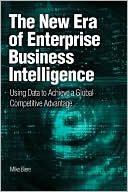The New Era of Enterprise Business Intelligence: Using Analytics to Achieve a Global Competitive Advantage
Search in google:
A Complete Blueprint for Maximizing the Value of Business Intelligence in the EnterpriseThe typical enterprise recognizes the immense potential of business intelligence (BI) and its impact upon many facets within the organization–but it’s not easy to transform BI’s potential into real business value. In The New Era of Enterprise Business Intelligence, top BI expert Mike Biere presents a complete blueprint for creating winning BI strategies and infrastructure, and systematically maximizing the value of information throughout the enterprise.This product-independent guide brings together start-to-finish guidance and practical checklists for every senior IT executive, planner, strategist, implementer, and the actual business users themselves. Drawing on thousands of hours working with enterprise customers, Biere helps decision-makers choose from today’s unprecedented spectrum of options, including the latest BI platform suites and appliances. He offers practical, “in-the-trenches” insights on a wide spectrum of planning and implementation issues, from segmenting and supporting users to working with unstructured data.Coverage includes• Understanding the scope of today’s BI solutions and how they fit into existing infrastructure• Assessing new options such as SaaS and cloud-based technologies• Avoiding technology biases and other “project killers”• Developing effective RFIs/RFPs and proofs of concept• Setting up competency centers and planning for skills development• Crafting a better experience for all your business users• Supporting the requirements of senior executives, including performance management• Cost-justifying BI solutions and measuring success• Working with enterprise content management, text analytics, and search• Planning and constructing portals, mashups, and other user interfaces• Previewing the future of BI
Chapter 1 Introduction to Business Intelligence Today 1Setting Expectations 3The Face of Business Intelligence Now 5The Characteristics of a BI Vision and Strategy 8Setting the Stage for BI Success 9Within the IT Organization 9Within the End User Community 11Summary 12Chapter 2 Defining Business Intelligence Today 13Defining Business Intelligence within Your Organization 13Platform Implications 15What Is "Mission Critical"? 17BI Solution Elements 18Business Intelligence and Data Warehouse: Are They Synonymous? 21Business Intelligence as a Key Differentiator from Competition 22Productivity Factors---Working Smarter 25Summary 27Chapter 3 The History of Business Intelligence within Your Organization 29Mapping Your Environment to the BI Evolutionary Tree 29Creating an Internal Record of BI Usage 34Analysis of Displacement 38Summary 40Chapter 4 The Scope of BI Solutions Today and How They May Relate to You 41The BI Infrastructure 41BI Drivers, Trends, Sources, and Deployment Options 44Mergers and Acquisitions---The Emergence of BI "Mega-Vendors" 45BI Suites/Platforms versus Independents 46Open Source BI Tools 47Software as a Service (SaaS) 48Cloud Computing 49BI Appliances 51Dynamic Warehousing-Extending Beyond Structured Information 52Operational and Real-Time BI 54ETL and Change Data Capture-Their Impact and Importance on BI 55Master Data Management (MDM) and Its Role within a BI Infrastructure 58The Impact of XML Data 59BI Provisioning Models-What Is Best for You? 61Establishing a BI Competency Center (BICC) 62Creating an Information Agenda 62Summary 64Chapter 5 Elements of BI Solutions: The End User Experience 65End User Assumptions 65Setting Up Data for BI 67The Functional Area of BI Tools 69Query Tools and Reporting 69OLAP and Advanced Analytics 71ROLAP Solutions Versus OLAP 73Understanding the Critical Role of Time Dimensionality 74Data Mining 76Text Analytics 77Spreadsheets-Effective Use and the Implications on Security/Compliance 79Executive Information Systems (EIS) 80Operational BI 83Embedded BI and Event-Driven Processes 86ETL/ELT and Real-Time Change Data Capture (CDC) Options 87Summary 90Chapter 6 The Impact of Business Intelligence on Roles within the Enteprise 93End User Categories 93End User Management 96Skills Definitions 98IT Support Roles 100BI Tools Support Staff and Business Analysts 101The Executive/Managerial Role 102Non-Technical and Casual User 104Summary 105Chapter 7 Corporate Performance Management and the Executive View of Business Intelligence 107Defining CPM 108Elements of a CPM System 109Vision 111Strategy Map 111Balanced Scorecard 112Dashboards 113Feedback 114The "PM"s Available Today 115The Executive View of BI 117Summary 118Chapter 8 Enterprise Content Management, Unstructured Data, Text Analytics, and Enterprise Search 121Enterprise Content Management (ECM) 123Enterprise Search 125Using RSS as a Conduit for External Information 129Text Analytics 130The Search and Text Analytics Project 132Text Analytics as a Part of the Complete BI Picture 133The Impact of XML on BI 134Summary 135Chapter 9 Key Influencers in the Enterprise 137User Segmentation Reality Check 138Identifying the Power Brokers-Key Influencers 140Attributes of Key Influencers 143Extending BI Beyond the Enterprise 144Summary 145Chapter 10 Justifying Business Intelligence Solutions and Measuring Success 147Justification Scenarios 148BI Roadmaps 148Articulating Potential Benefits 150Business Unit Impact on Justification 151Big Purchase...No Plan 153ROI, TCO, and TCA 156Measuring BI Success 158BI Clouds and Outsourcing 160Summary 161Chapter 11 Platform Selection, Technology Biases, and Other "Traps" 163Platform Selection for BI Tools-The Database View 164Platform Selection for BI Tools-The Tools View 166Technology Biases 168Other BI "Traps" 170Handling Biases 170Summary 172Chapter 12 Intelligent Responses to an RFI/RFP and Setting Up a Proof of Concept/Technology 175Creating a Better RFI/RFP 176Get into the Details 176Coordinating IT and Business User-Ranking the Proper Criteria 179Data Access and Performance Aspects of an RFI/RFP 179Documenting RFP/RFI Information for the Future 181The PoC/PoT Scenario 182Matching RFI/RFP Checklists to a PoC/PoT and Documentation 184Summary 185Chapter 13 End-User Support and Productivity 187WYNTK-What You Need to Know About BI Support 188Centralized Support-A BI Competency Center (BICC) 191Methodology of Work Submission and Success 195Vendor BICCs 196Productivity-A Valuable Offshoot of Effective BI 197What Is End-User Productivity? 197Summary 199Chapter 14 Implementation of Business Intelligence Solutions 201Setting User Expectations Early and Coping with the First Project 202How to Scope the First Project 203BI Skills Required 205End-User Provisos 207BI Solution Elements-Query, Reporting, OLAP 208Query and Reporting Application Elements 208OLAP Application Elements 210System Sizing, Backup, and Recovery Issues 212System Sizing 213Backup and Recovery 214Summary 215Chapter 15 The Impact of Service-Oriented Architectures (SOA) on Business Intelligence Solutions 217SOA...So What? 218Is SOA Practical for BI? 220Getting Started with a BI SOA 221BI SOA Frameworks 225Summary 227Chapter 16 Enterprise Portals, Mashups, and other User Interfaces 229The Enterprise Portal-Its Purpose and Potential 230Mashups-A Perfect BI Delivery Model 234Understanding BI in the Context of Portals, Mashups, and Collaboration 235Summary 239Chapter 17 An End User Survival Guide 241BI Basics 242Ease of Use, Leprechauns, and the Yeti 243Interacting with BI Tools and Features 244The BI Skills Conundrum 247So Who Are You? 248BI Skills Assessment 250Do You Have a Standard for Naming BI Objects? 253White Board the Data Sources and Combinations 254Summary 256Chapter 18 Checklists for BI Planning 257An Enterprise Checklist 258The Business Unit Level Checklist 260A BICC Checklist 262An IT Checklist 264Summary 266Chapter 19 Speculation on the Future of Business Intelligence 269Emerging BI Technologies 270Technology Gaps 274Trends to Monitor 276Responding to Trends 278Summary 279Index 281







